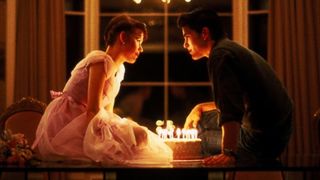Media
To All the Teenage Romance Films I’ve Loved Before
Why young adult romance still gives us butterflies.
Posted September 4, 2018

It’s the most tantalizing, alluringly visceral scene in cinema for me: when otherworldly handsome Jake Ryan returns the undies of charmingly normal Samantha before sharing their first kiss over a birthday cake. It’s the sweetest climax to an otherwise horrible sweet sixteen for Sam, whose birthday has been unabashedly forgotten by everyone in her life. The film, as you are probably aware, is one of John Hughes’ coming-of-age masterpieces,Sixteen Candles (1984), starring ‘80s darling Molly Ringwald, the girl that every normal girl in America lived vicariously through.
Decades after I saw the film, it still remains one of my absolute favorites. It's one of those movies that regardless of when you start it, you’ll watch and savor until the end credits, when the instantly recognizable synth beats of “If You Were Here” by the Thompson Twins begins to play. The scene depicts the kind of magical romance that feels a little like winning the lottery—it’s not likely, but maybe, just maybe, it could happen to me. At least that’s what I believed whenever I watched this film as a lovelorn, boyfriendless teenager who longed for the handsome, popular boy at school to notice me— and then quickly fall in love with me.
That never happened of course. What did happen? John Hughes made Pretty in Pink (1986) and introduced the opposites-attract pairing of wealthy, heart of pyrite, Blane (the most crushable Andrew McCarthy) and fashion challenged, wrong-side-of-the-tracks Andie (Ringwald basically playing a poorer version of Sam). Again, it was the stuff of average girl dreams. Andie was courted by not only Blane, but also by her best friend and halfway decent lip syncer Duckie (Jon Cryer). The original ending, as the filmmakers revealed recently, featured Duckie and Andie getting together, but was ultimately scrapped when test audiences (i.e., teenage girls) objected:
“The girls in the test screening didn’t go for that. They didn’t care about the politics; they wanted her to get the cute boy. And that was it. So we had to reshoot the ending.”
Even Ringwald herself, admitted she thought of Duckie as her gay best friend, not a love interest. Plus, it’s Andrew McCarthy.
The first time I watched these films, I was in my early teens, a few years younger than the characters. I recall watching the screen in awe, thinking about how intelligent, mature and thoughtful these 16-year-olds sounded. They were pre-Dawsons’ Creek teenage intellectuals. Even now James Spader who played smarmy villain Steff, still comes across as older and more sophisticated than me. (This may be because he was 28 when the film came out, older than the rest of the cast, but definitely younger than me now.)
So it came as a surprise to me when my nostalgia for these iconic teenage romances was recently reignited while watching To All the Boys I’ve Loved Before, a new Netflix film based on the bestselling young adult (YA) novel by Jenny Han. I hadn’t read the book, but was enticed by the casting (an Asian-American actress was playing the romantic lead!) and the onslaught of social media buzz from women my age who couldn’t stop raving about it. Still, I didn’t have very high expectations. As far as I could tell, the only coming-of-age films worth watching were Molly Ringwald’s relics of the past.
And then I quickly ate my words.

In short, To All the Boys is a pure delight. Lara Jean, like Andie and Sam before her, is the quintessential average girl from cinema that knows she’s special but has a problem with everyone else seeing it… until the hot guy eventually does too. The story tells of the aftermath of what happens when a teenage girl’s love letters (which are never meant to be sent) are mysteriously delivered to each of her crushes. In Lara Jean’s case, the hot guy, played by eye candy Peter (an incredibly charming Noah Centineo) seemingly falls for her early on, even though she is unwilling to admit it. Of course, the truth is obfuscated by her own lack of confidence, a series of misunderstandings, and a predictable Can’t Buy Me Love inspired agreement, but like in every John Hughes movies from yesteryear, true teenage love eventually prevails in the last five minutes on screen.
Even as someone who is now more than twice the age of the characters, I could so easily put myself in their shoes. I recall having done so in my (cringeworthy) teenage years. In many ways, I grew up like Lara Jean, the protagonist of the story. Remember this earlier line? I was a lovelorn, boyfriendless teenager who longed for the handsome, popular boy at school to notice me. In my case, no love letters went rogue to their recipients, but there were all-too-real moments where crushes were inadvertently exposed and the waiting period of finding out if feelings were reciprocated was agonizing. (Alas, most of the time, they were not.)
But by watching Laura Jean’s story unfold, I could suddenly see myself in an alternate universe where my crush also had feelings for me. For most of the film, I remember feeling entirely nostalgic for my teenage years and desperately longing for a do-over, a second chance to make things right. This desire for adults to live vicariously through young adult fiction shouldn’t really be that surprising. After all, it’s why 55 percent of YA readers are adults and why YA fiction consistently remains one of the bestselling book categories around the world.
In fact, nostalgia and escapism are what makes the YA genre so universally appealing. For The Guardian, Georgina Howlett writes:
“YA books are great for evoking nostalgia; they can often remind older readers of their childhoods and teenage years, making them a comforting presence for those who just refuse to grow up and embrace their boring, often excitement-free adult lives.”
Nostalgia, by definition, has a tendency to make us have a rose-tinted view of the past—enabling us to romanticize even our tragedies, which is why nostalgia and love together are such an enticing combination. First love is a particularly powerful strain—since it’s the only one you never really forget. Psychology professor Art Aron explains:
“Presumably there’d be more arousal and excitement, especially if it’s scary. And falling in love is somewhat scary—you’re afraid you’ll be rejected, you’re afraid you won’t live up to their expectations, afraid they won’t live up to yours. Anxiety is a big part of falling in love, especially the first time.”

That this experience usually occurs during adolescence—a period of crazed hormones and other memorable “firsts” (e.g., bad grades and kisses)—can help us to think of our first loves as larger than life, even if they weren’t anything more than going on a single parent-supervised date to watch Baz Luhrmann’s Romeo + Juliet at the movie theater. This is also probably why listening to songs associated with certain adolescent crushes still give me goosebumps.
That is not to say that all YA books and films have universal appeal. I may be one of the 10 people on earth who was never interested in the Harry Potter series. Like with everything else, we fall in love with what resonates with us. I just happen to be a sucker for characters who remind me of me. After all, by watching the awkward, average, overlooked girl get swept off her feet lets me pretend it happened to me, too.




